Design Investigation & Research IBM Graduation Project
The curious case of greens
A design research case study on finding ways to improve the fresh produce procurement and consumption in an urban food system to make it sustainable.
My contribution
I contributed to the design research, analysis and insight generation, and concept development
Team
Design Researcher & Experience Designer - Anurag Das
Extended design team for brainstorming & design critique - Pratyaksha, Alisha Nisar, and larger IBM IX team
Duration
8 months
Overview of a
food system
Before we move to the specifics of what the project is about there was a larger system to understand, the food system. Understanding this would help us familiarise ourselves with the cause and effect of the system and its relation with the others.
As a wise person once said, "All things appear and disappear because of the concurrence of causes and conditions. Nothing ever exists entirely alone; everything is in relation to everything else."
The Oxford publication: future of food defines a food system as
The food system is a complex web of activities involving production, processing, transport, and consumption. Issues concerning the food system include the governance and economics of food production, its sustainability, the degree to which we waste food, how food production affects the natural environment, and the impact of food on individual and population health.
This interconnected web of activities together forms the food system. We are what we eat and that defines the ecosystems that we live in, and largely the environment. The food system interacts with other related systems in the world, e.g the social, health, economic & environment. There are various types of food systems in today's world. As our species evolved, these food systems around us evolved as well. The demands of the rising population, the depleting natural resources have stretched our food systems and the call of the hour is to find ways to make them sustainable.
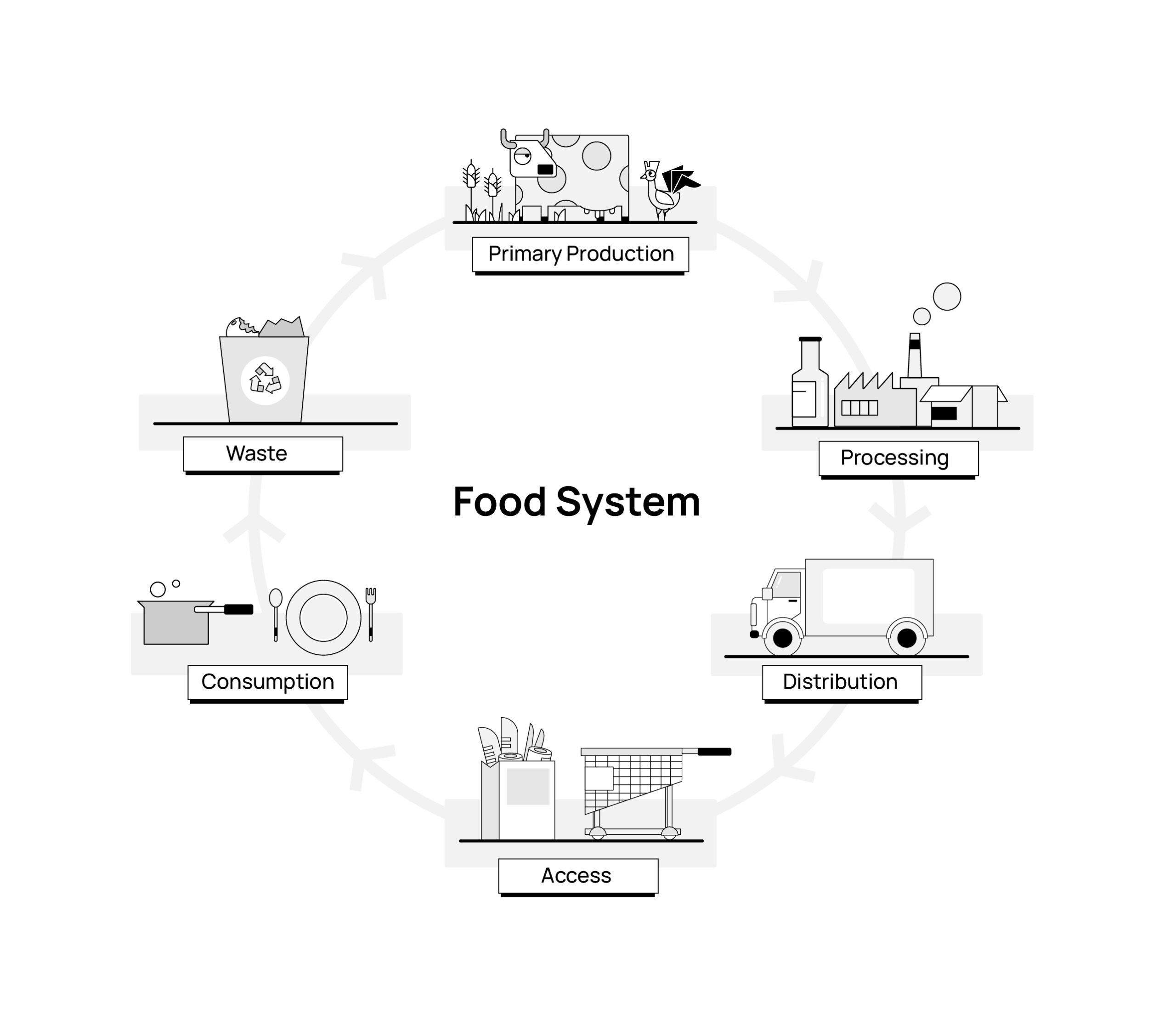
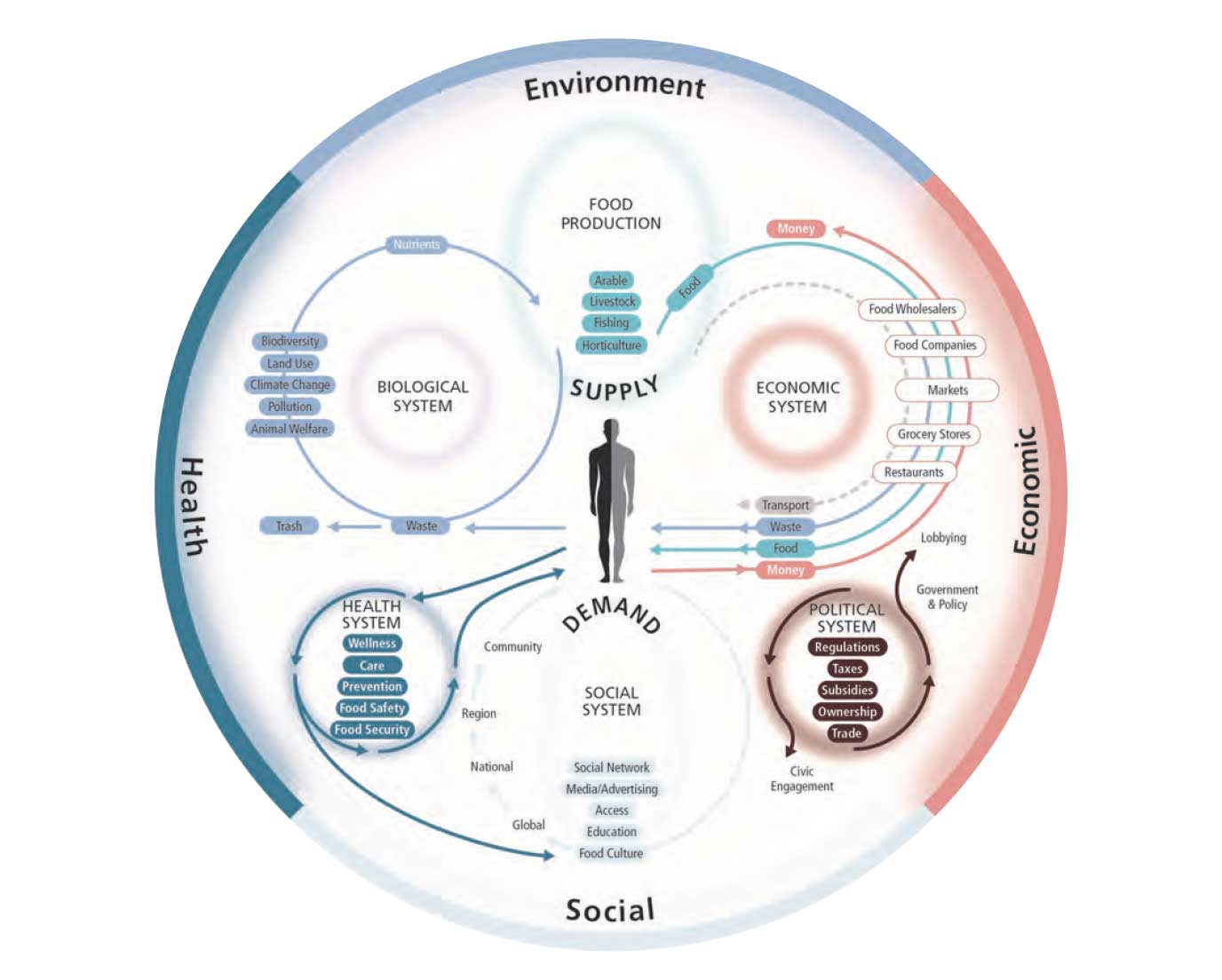
Concerning
Assumptions
After running an initial secondary research browsing through articles and reports trying to find current concerns related to food systems and their future, these were a few notable points of concern
- Food Safety: Studies say that players in the meat, dairy, eggs, and bagged greens industries are unsafe at any speed. Multiple news articles stated the presence of highly toxic components in the food and produce being consumed.
- Meeting the rising demand of diet diversity: Staple grain production and consumption has driven India’s food system since the success of the Green Revolution. Today, however, the Indian population requires and is demanding healthier and more diverse foods.
- Lack of equal access: Our food system is unjust because it does not provide healthy, affordable food to everyone. People in urban areas often have no access to any fresh food at all because there are no grocery stores. Likewise, rural residents in the heart of agricultural areas sometimes cannot afford to buy the very food they may help to harvest.
- Food wastage: One of the major ways of addressing food insecurity is controlling wastage. It’s the most obvious place to start. India is the second-largest producer of vegetables and fruit but 25 percent to 30 percent of it is wasted due to inadequate logistical support, lack of refrigerated storage, supply chain bottlenecks, poor transport, and underdeveloped marketing channels.
Initial
Design Research statement :
Identify and explore the possible consumer-centric food systems contextual to the region and measure their sustainability.

Setting context
& doing groundwork
The next step was to plan my research with context to the place that I was in, Bangalore.
Bangalore or Bengaluru—is the capital city of the province of Karnataka in southern India is known today—has since the mid-1990s been referred to as the ‘Silicon Valley of India’. Expanding new opportunities in the booming city initially attracted skilled migrants from within the province and neighboring areas, but gradually also from different parts of the country.
As a starting activity to define my research statement I wanted to get a first-hand understanding of how few of the food systems in Bengaluru functioned. I tried to categorize a few food procurements and consumption retail segments/services and ran an observation and insight study.
The research method used: Fly in the wall
This helped me familiarise myself with the urban food procurement systems and also map out a few directions to guide my research. A few key points to observe from these visits were
- The kind of businesses they were and the facilities they provided
- The type of users each of these centers attracted and their behavioral patterns
- Observations on sustainability quotient.
The detailed observations were documented and eventually helped me to choose a user segment to further narrow down my research.



Asking a few
questions
over lunch
The on-site visits turned out to be very valuable as they provided some good insights into the food procuring systems in urban Bengaluru. The next step was to understand a little bit about food consumption behavior as that is a key factor in driving food procurement.
I tried to start the research process by doing a small QnA with myself as a participant and later included 5 more participants to gather more data. The idea of this exercise was to test an individual's knowledge on how much they know about what they are eating in a meal, and what factors drive them to eat what they are having. The larger concerns that were driving this experiment were food safety, food provenance, consumer awareness & responsibility, and consumption patterns & demands, and how they affect the larger ecosystem.
Research method used: Design Ethnography
The questions I asked myself over lunch were -
- What am I eating?
- How did I procure/cook this dish?
- How much do I know about what is on my plate?
- Why did I eat this particular dish?
- Do I know where the ingredients/produce are coming from or their provenance?
Even though the answers to these questions were quite obvious they did bring in some strong realizations on what my role is as an individual in a food system.
"It was quite surprising to know how my decisions on what I eat actually connects to my cultural background, my daily routine, my last vacation, my refrigerator stock, an Instagram post, and my cook's leave."
I tried to send this set of questions to a few of my close friends/relatives/colleagues to check their responses. The documented answers and observations from the collective responses helped me notice wider patterns and themes on how people of various ages and roles/occupations decided on what they wanted to eat for a particular meal and how aware are their choices.

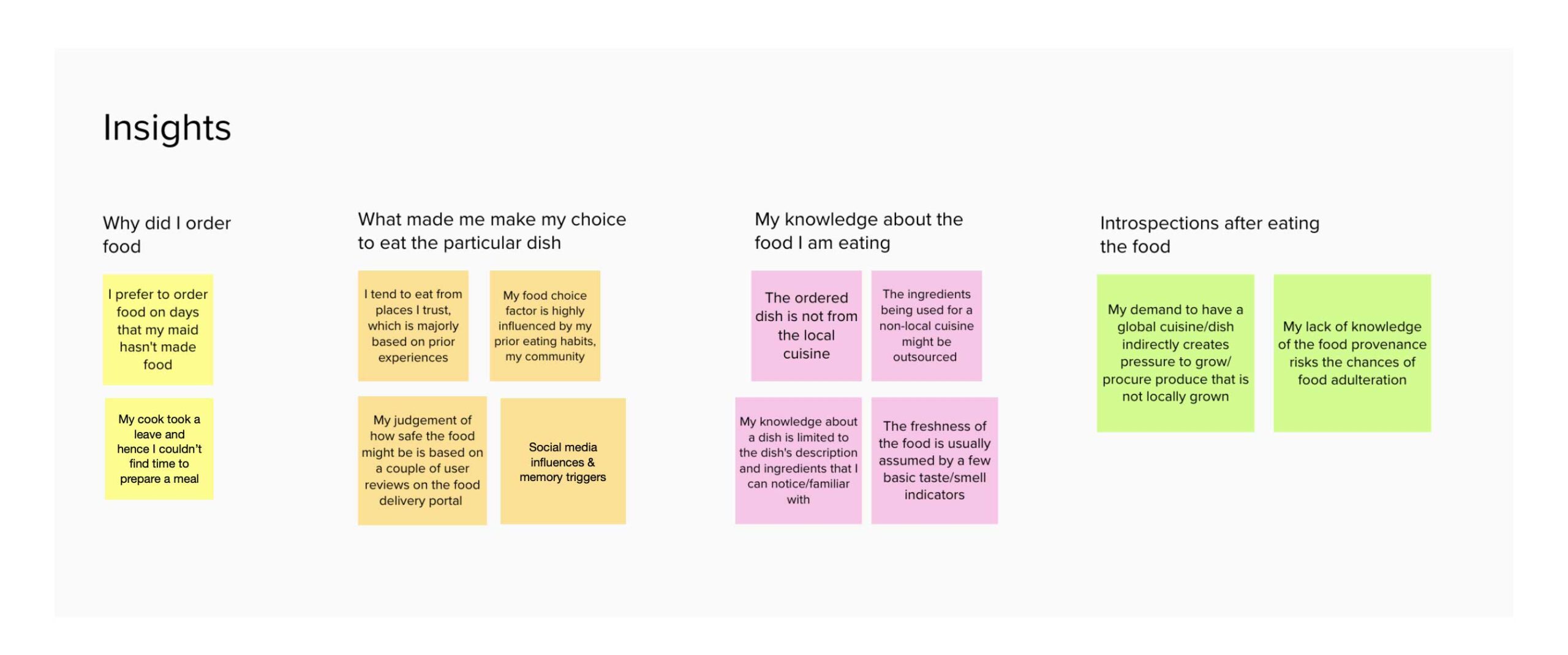
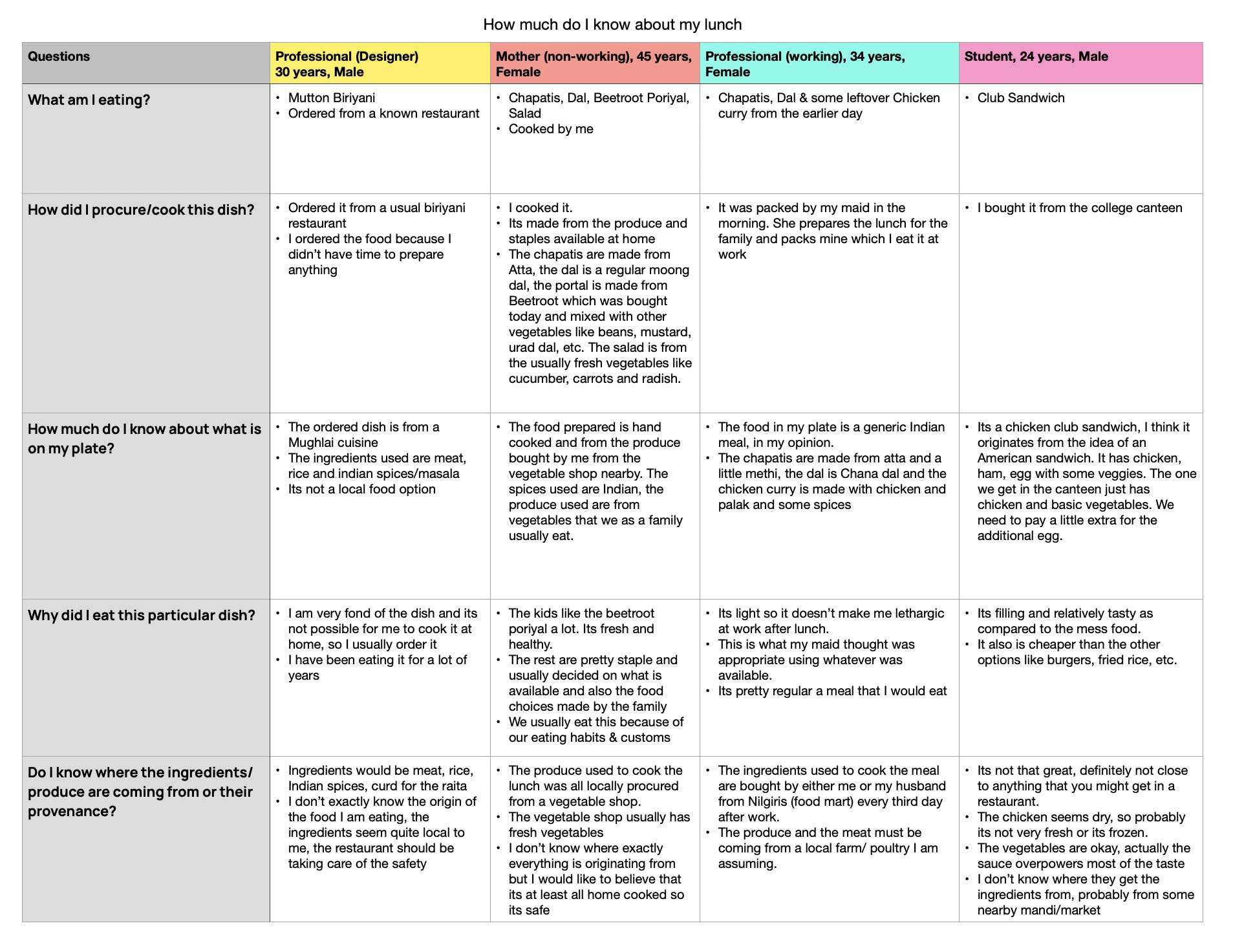

Choosing a sector
in the larger system
The research so far helped me reach the following broad conclusions, The consumer-centric urban food system is very large to be tackled as a whole, the urban population has a multi-diverse food palate, the general urban consumer prioritizes convenience over awareness, The lack of awareness in a consumer drives him/her to make unsustainable choices in a day to day life. The next step was to converge to a branch within the urban food system to conduct a more detailed study.
In order to narrow down to a topic to work on, I looked up a few white papers & articles on a few growing concerns in the consumer-centric food system in India. These were the following findings
- Indian diets lacked the consumption of fresh produce as per data.
The data from the recent findings state that there is quite a difference between the consumption patterns of the urban and rural populations. - There is a lot of concerns in the domain of food safety from the perspective of perishables, focusing mainly on fresh produce.
- There is a growing sector of the urban population who are inclining to a healthier lifestyle and a more sustainable way of living. The choices made in fresh produce procurement & consumption are driving factors for adapting to this change.
Here are a few clippings from the news articles and the white papers that highlight the concern

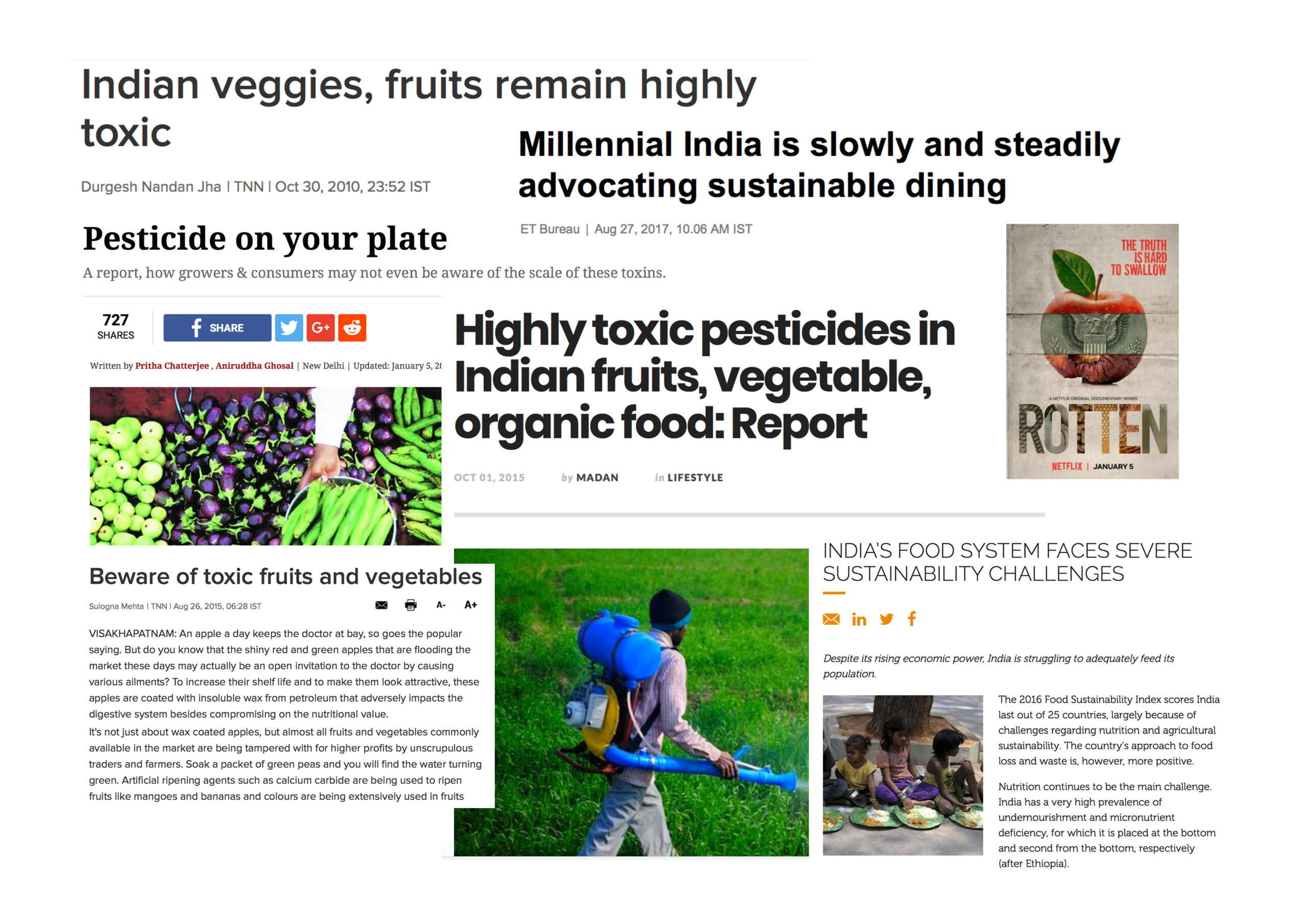
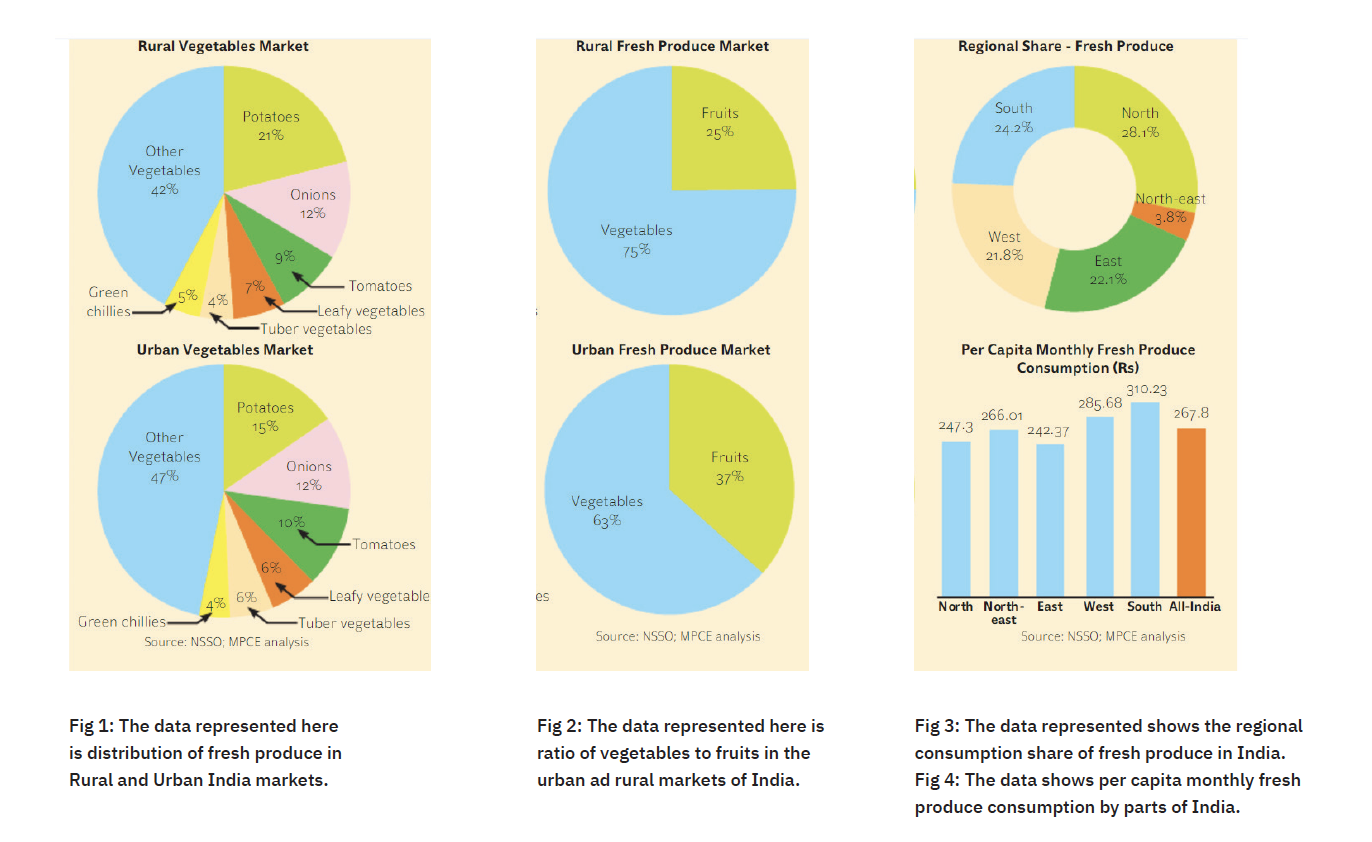
Initial Revised
Design Research statement :
Identify and explore the possible Improve the experience of fresh produce procurement & consumption contextual to the region and measure to create sustainable consumer-centric food systems.

Identifying the
target audience
After revising my design research brief, I had to focus on gathering some individual feedback from people to get a larger perspective. This meant conducting user interviews and gathering insights. Before moving on to the actual interviews there needed to be a categorization of the users who I planned to focus my interviews on. This broader segment of audience was decided on a few factors -
- Occupation
- Age
- A holistic representation of the urban population of Bengaluru
- Modern societal roles in the urban population
I ran this step of research in two parts -
- Going back to the fresh produce retail centres and have small topics of conversation about their buying frequencies, what do they look for when they procure fresh produce, what more are they expecting, etc.
- Conducting detailed interviews with participants to get more insights based on a questionnaire prepared from insights from Step 1 of the process.
The intial interviews and conversations with consumers in the procurement retail centres were documented and analysed. The small topics of discussions were around understanding the how often do they procure produce, what are the drivers for decision making, what are some general concerns around fresh produce procurement & consumption, what are their pain points.
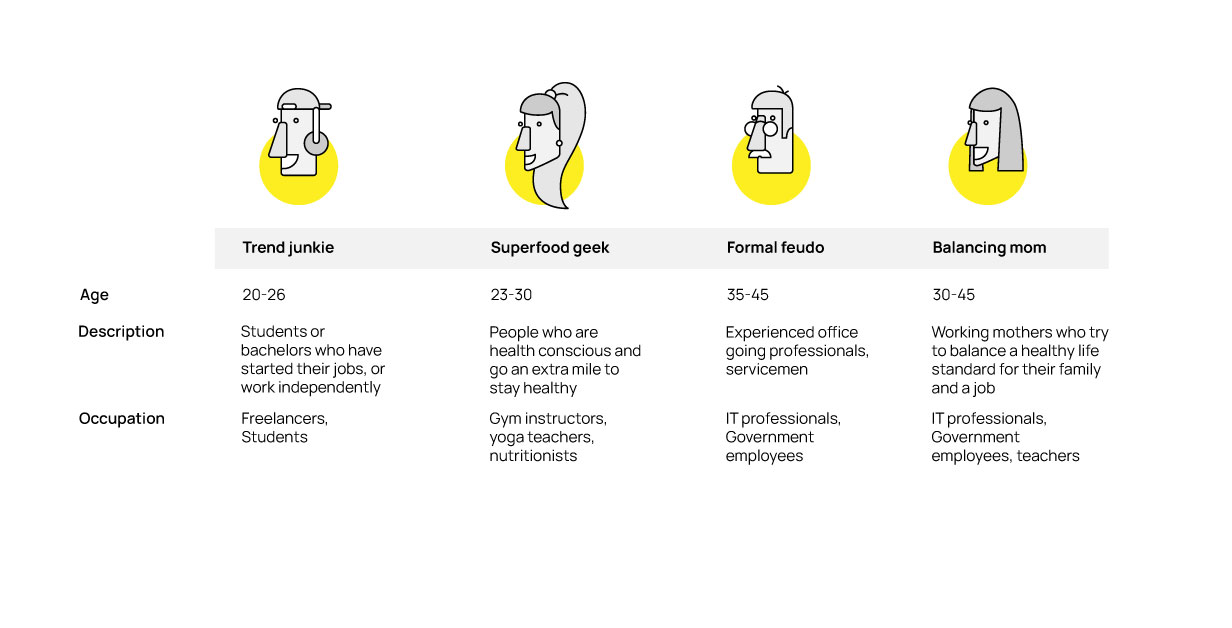

Interviews & user perspectives
The first set of informal conversations and interviews with the consumers at these retail procurement centres helped me gather a collective opinion & perspectives of the urban population who procure fresh produce.
I spoke to the consumers & the shopkeepers/sellers to get a perspective of both the sides of demand and supply. These are a few user quotes from consumers & shopkeepers as per the retail centre -
After capturing the responses and the insights, the next step was to conduct detailed interviews with participants from the target audience. The idea of doing this was to capture richer details into behavioral patterns & decision-making factors that drive users to make their choices.
The questionnaire prepared was created in a three points
- A primary question
- The motive behind the question
- Probes
Question - Where do you usually eat your meals
Motive - Trying to understannd food consumption scenarios
Probes- Do you cook yourself? Who cooks for you?
These questionnaires were part of the detailed interviews I conducted with my target audience. The sample size for the detailed interviews were 26 people. The 26 of them comprised of 9 males & 17 females. The interviews were recorded and further documented to further analysed to find insights.
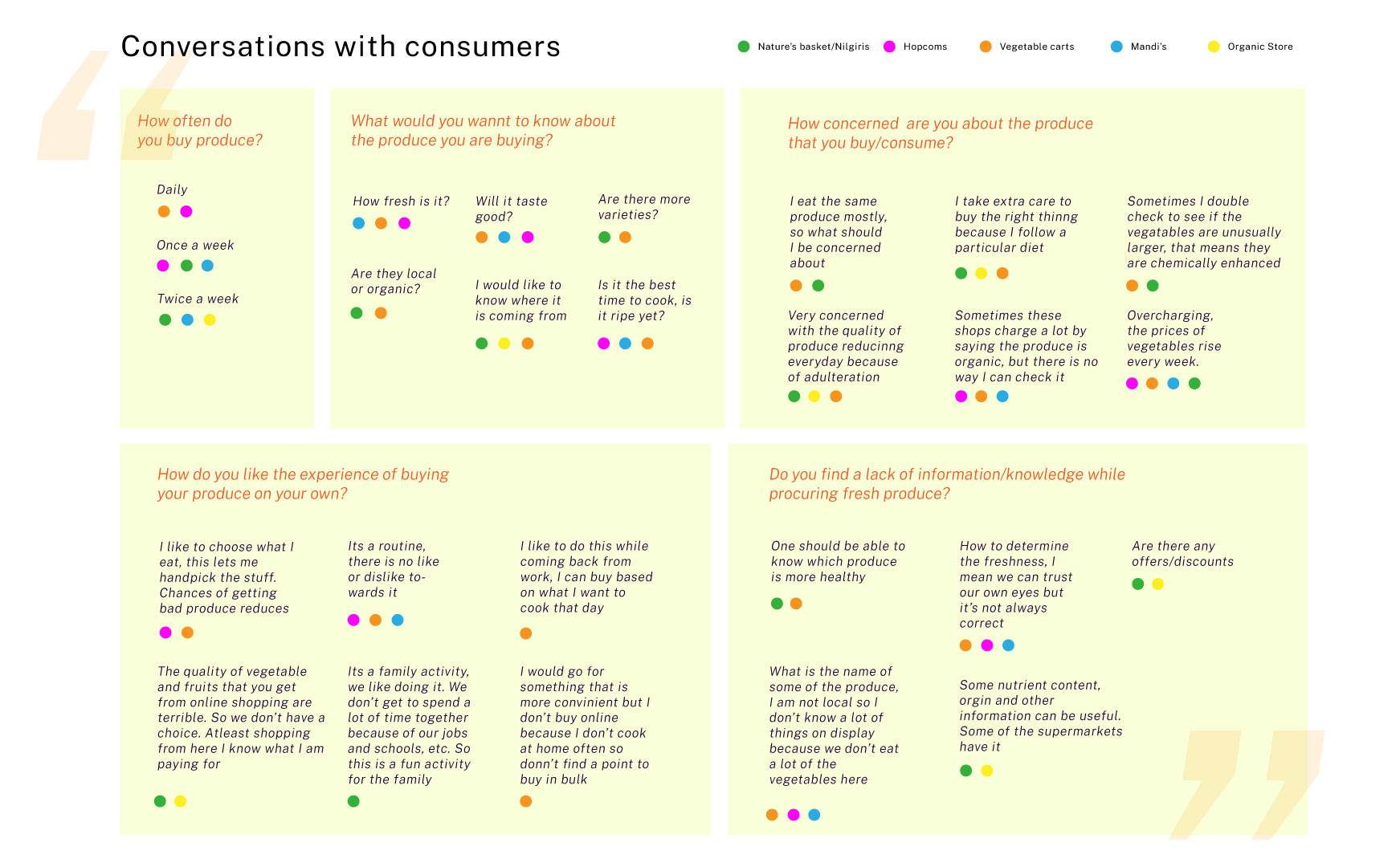
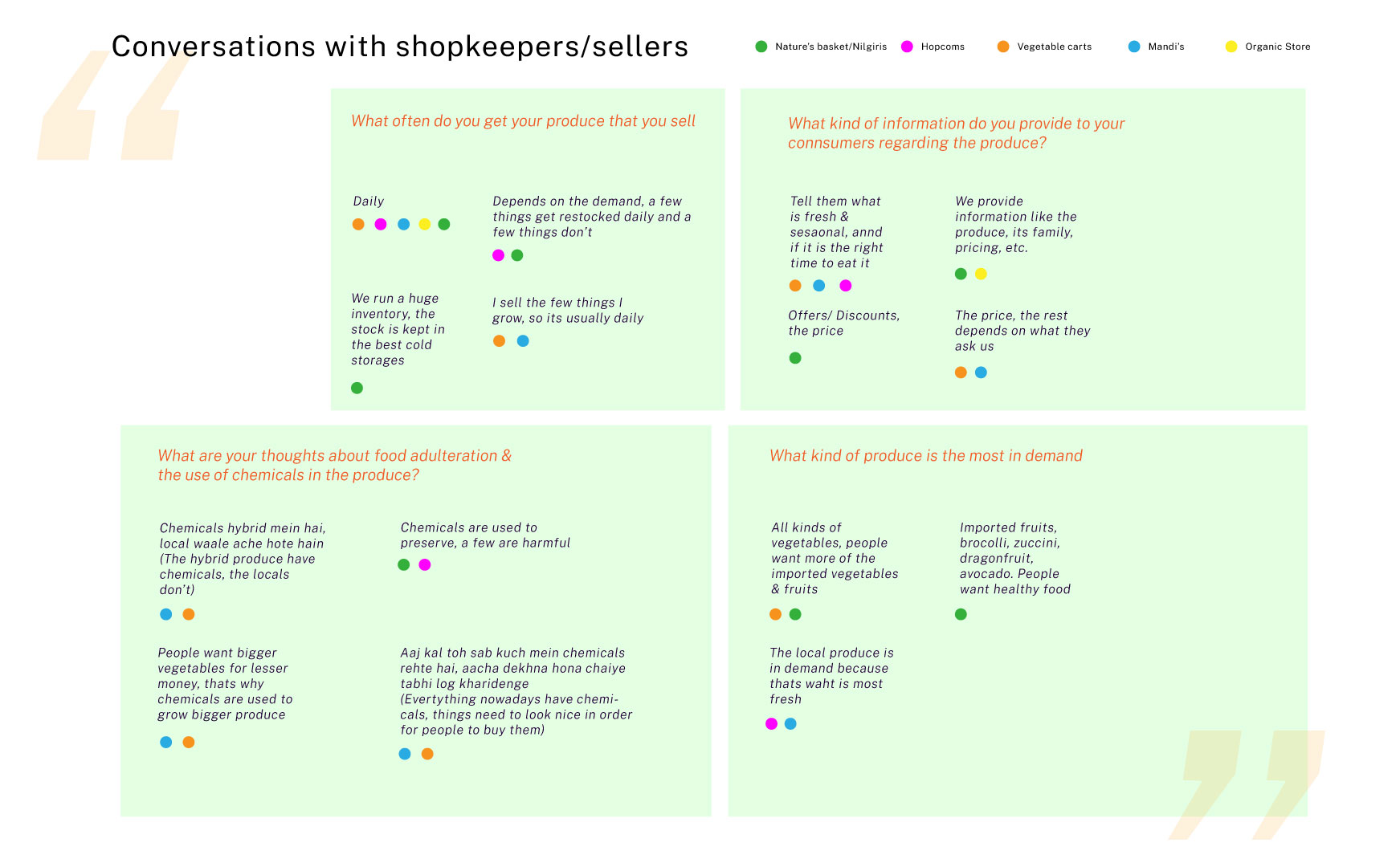


Analysis &
Insights
The conversations and the interviews together left me with a lot of perspectives from people regarding how they choose their fresh produce and what drives their decion making. A few key points that can be highlighted as insights were
- 70% of my participants who procured fresh produce from an offline store were working women.
The other 30% comprised of mainly men and a few students. - 60% of the participants were concerned with what they were eating & wanted to know more about it.
20% were indifferent towards it. The rest 20% seemed confident that they knew everythinng about what they were eating. - 80% of the particpants were commited to the idea that they are health conscious.
10% were not interested in a healthy lifestyle and the other 10% were interested but not actively doing anything about it - 40% of the participants were aware of the concept of sustainability.
There is a misunderstanding of the concept of sustainability being related to only organic produce, which is not well accepted by the amount of misinformation in the market about organic produce - 70% of the participants are aware of concerns related to food safety, but don't know how to address them.
30% trust the places they buy the produce from. They trust the brand/certifications/relations with the shopkeeper to ensure that they are getting safe fresh produce. - 40% of the participants let their chef/cook's decide on what produce needs to be procured.
The reasons for having a cook take control of their consumption choices were busy lifestyle, de-prioritizing food consumption over other activities and convenience. 50% of the participants cooked their own food and 10% ordered food from outside.
These were some key analysis of the data generated from the participant responses. The entire cyclic user journey from planning, procuring and consumption was mapped to the way a user might go about the whole journey. The mapping shows the interconnectedness of the cognitive process.
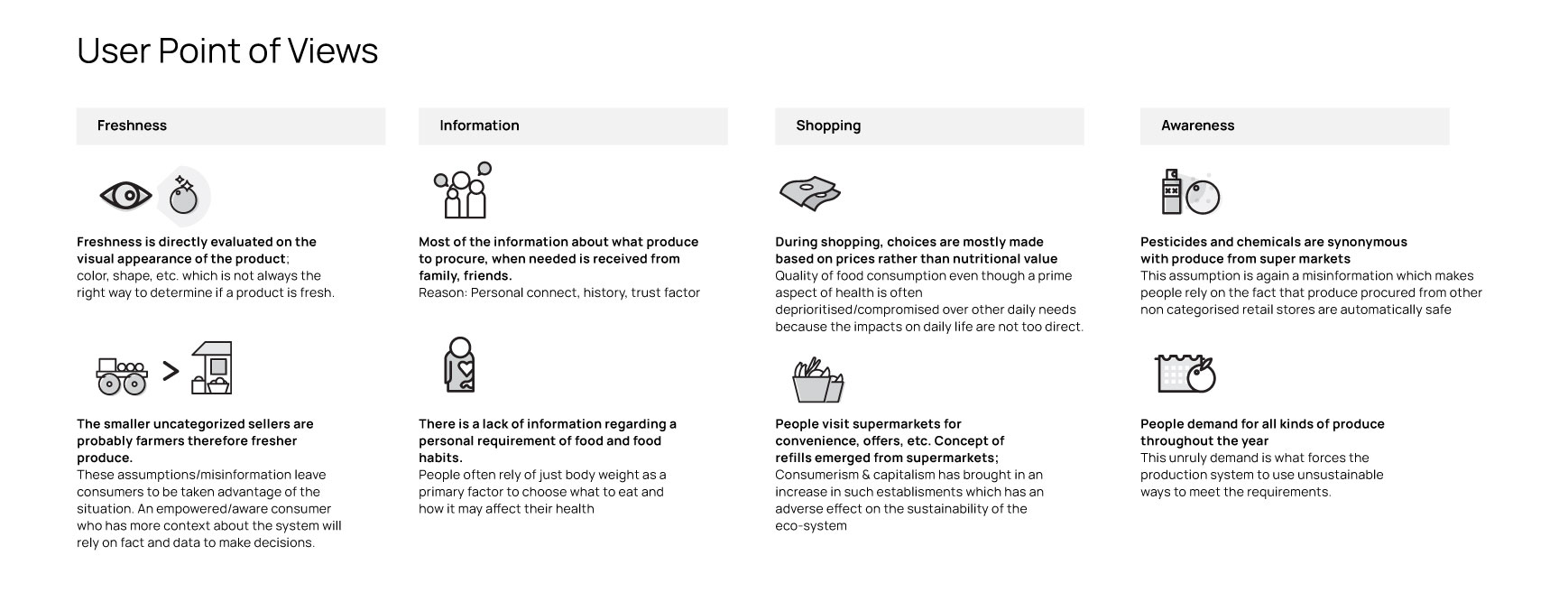
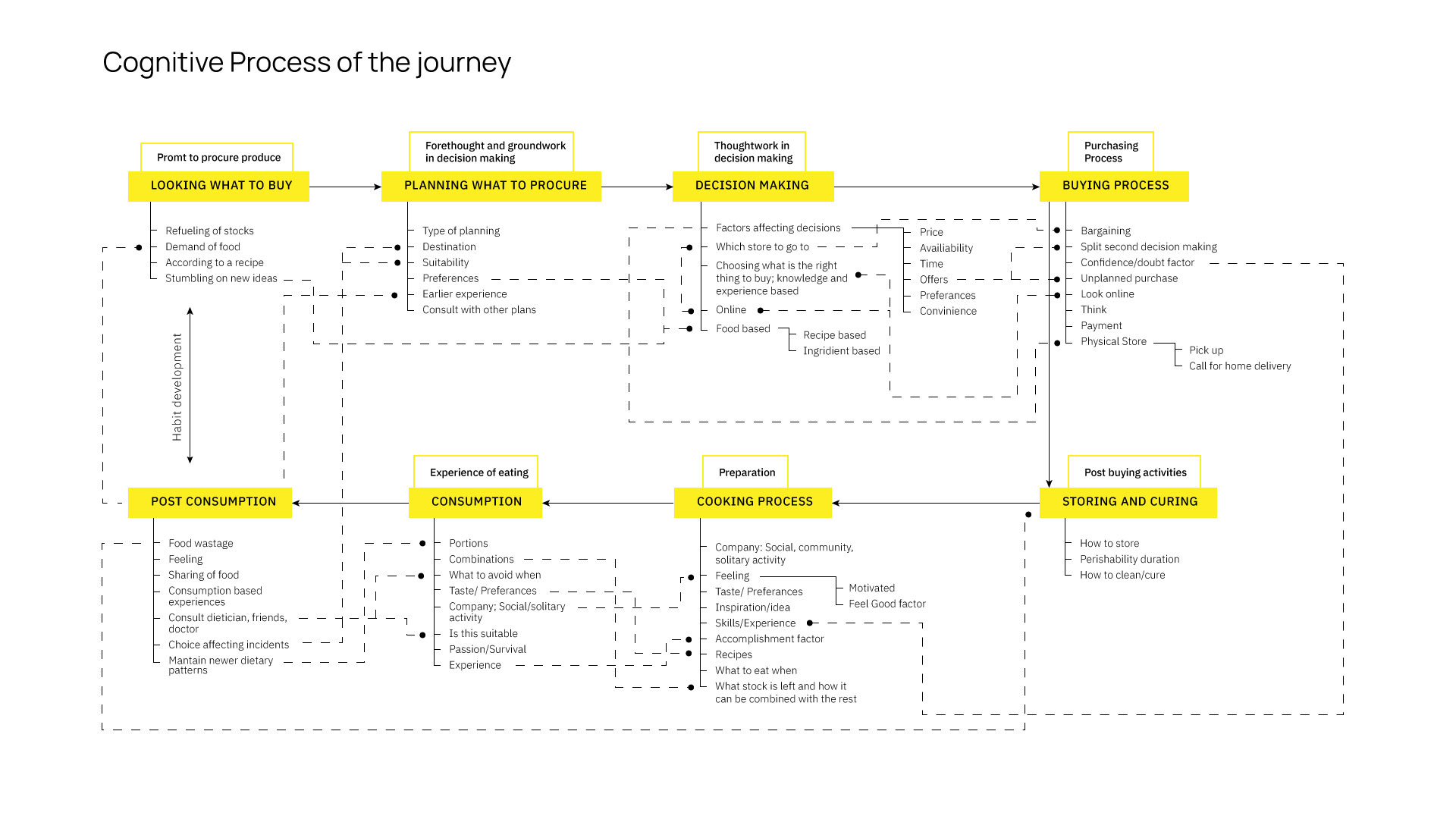
Experts say
After analysing the interviews and drawing out insights, I considered speaking to a few experts to understand their perspectives about the topic and also validating my findings.
I spoke to two experts from the field of food. The discussions were around how users perceive the activity of fresh produce procurement & consumption. Both the experts I consulted highlighted aspects of unsustainability in the current way of how we procure and consume fresh produce. Their perspectives & viewpoints are shown below through a few quotes trying to capture the gist of our conversations.
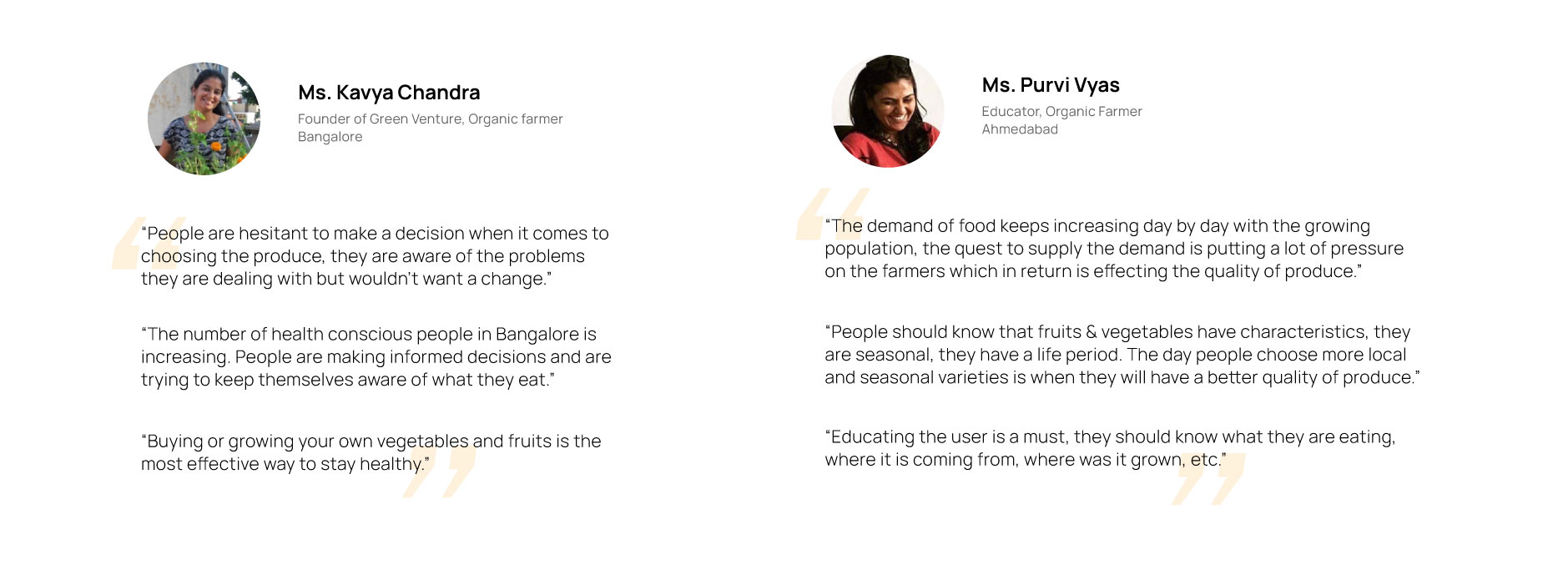
Emerging Themes
The research done till this point highlighted a few themes. These themes broadely categorise lifestyle and technological trends related to consumer centric fresh produce prucurement and consumption.
These lifestyle themes represent urban trends from user perspectives and understandings, behaviour and food choices & dependencies. The technology themes talk about the possibilities of improvement as we try to leverage upcoming technologies to address the lifestyle themes.

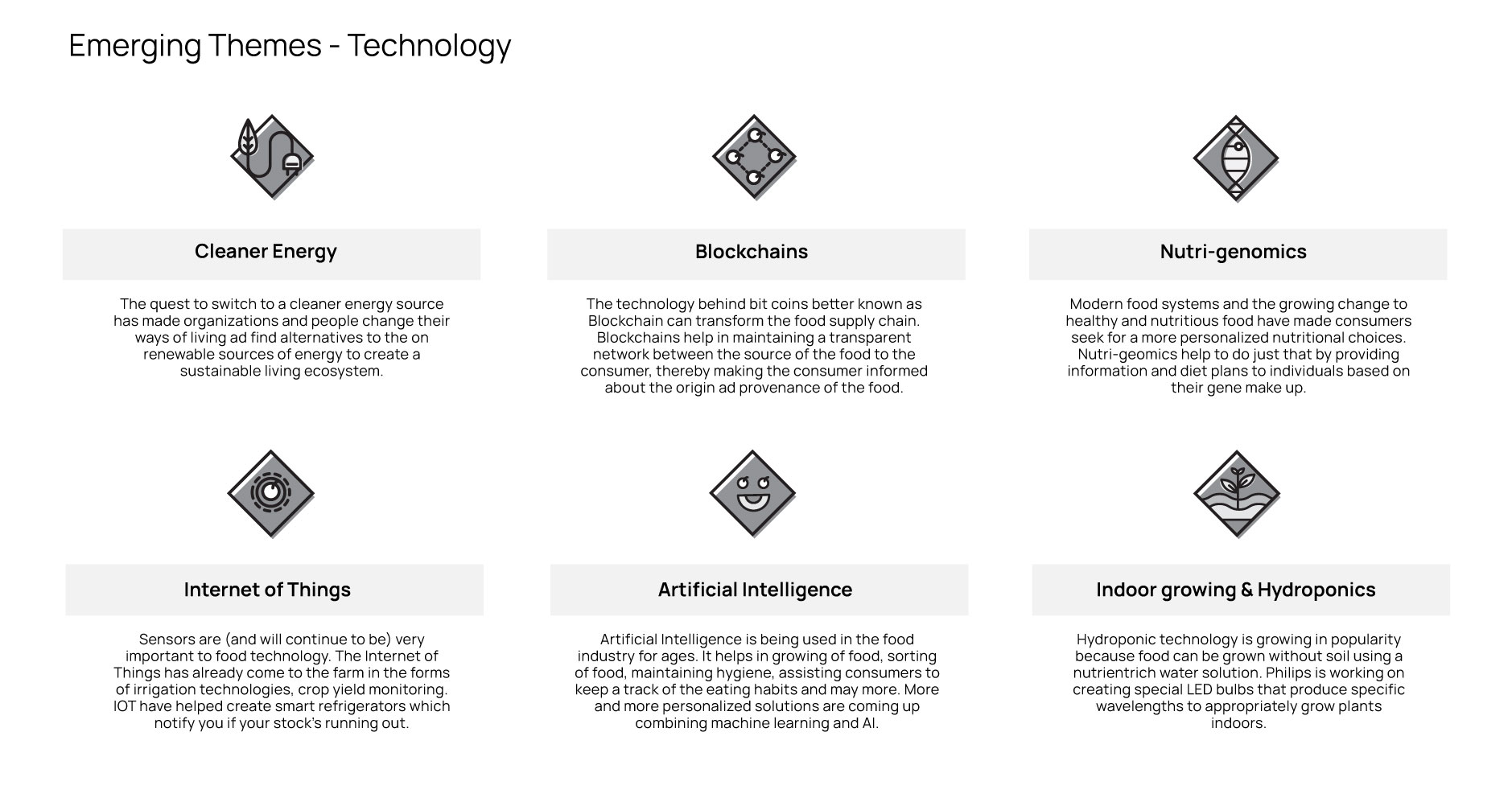

Insight statements
to How Might We's
The themes helped in converging the design research meaningfully. The next step was to create insight statements for each of the emerging lifestyle themes. These would help in converging the research and point the way forward.
Research technique used - Insight Statements
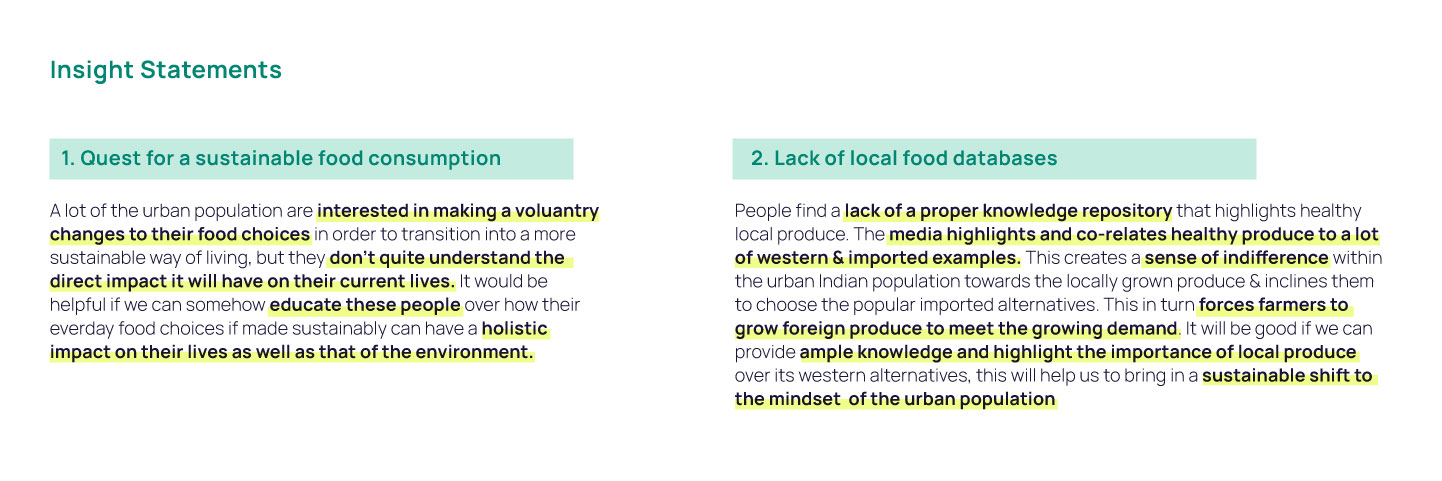


The insight statements helped me contextualize the focus area for the particular themes. These statements were used to narrowed down and prioritized further to come up with 'How Might We' statements.



Final
Design Brief :
Design a service/system that enhances the experience of fresh produce procurement and consumption for an urban population to ensure a healthy & sustainable food consumption.
Personas
The personas created were representations of individuals from the target audience group defined earlier. These individual personas can be easily found in the urban population of Bengaluru. There were 3 personas created to capture the diverse backgrounds and charataristics of the target audience.
I try to put the personas in a quadrant of characteristics and motives to better understand their decision making patterns.

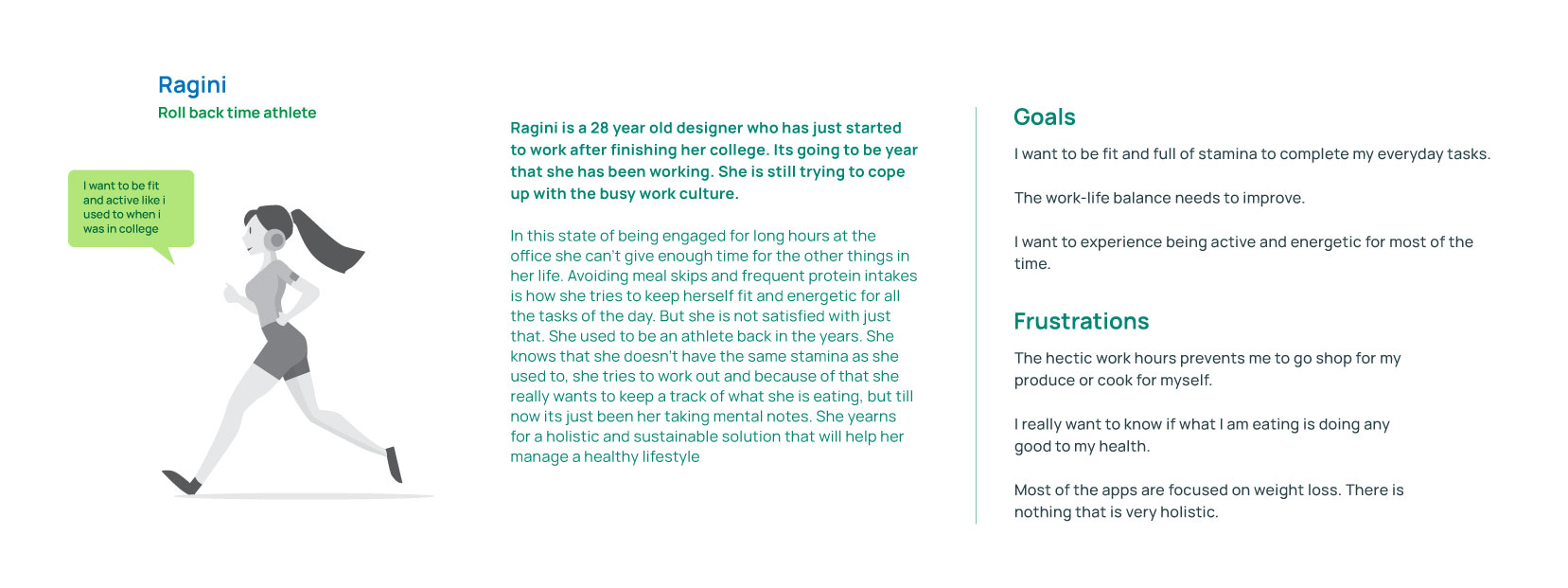
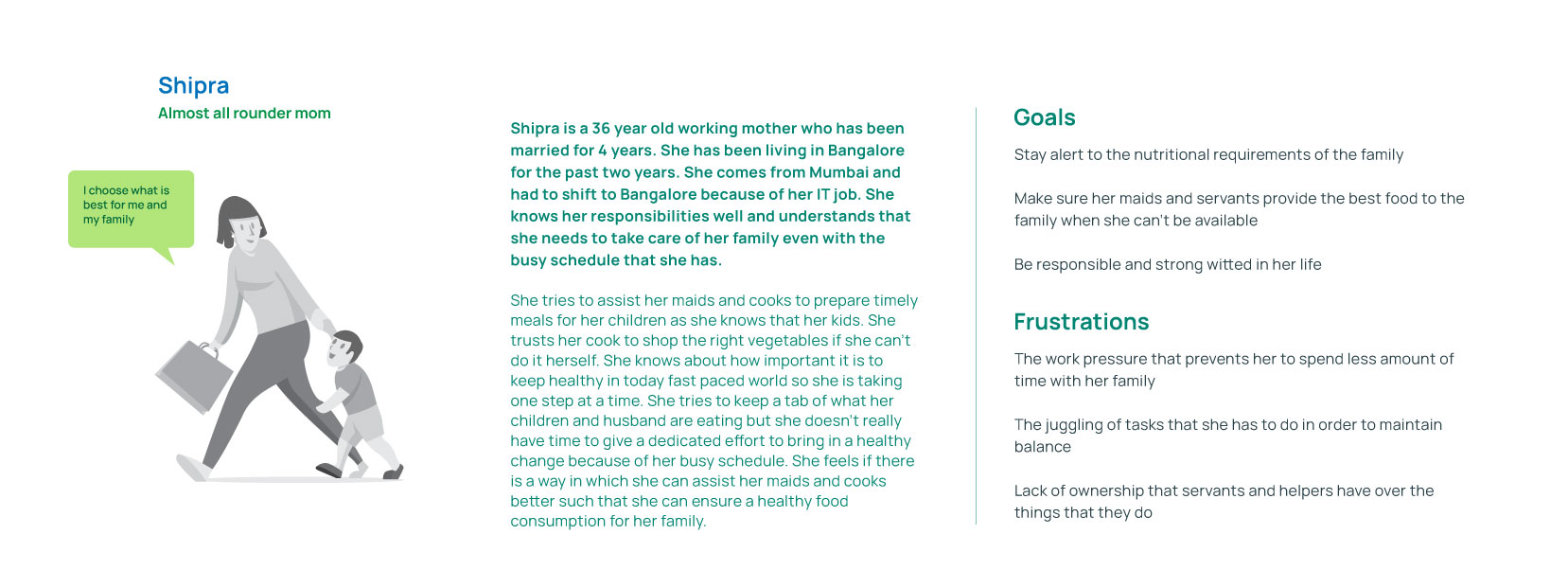

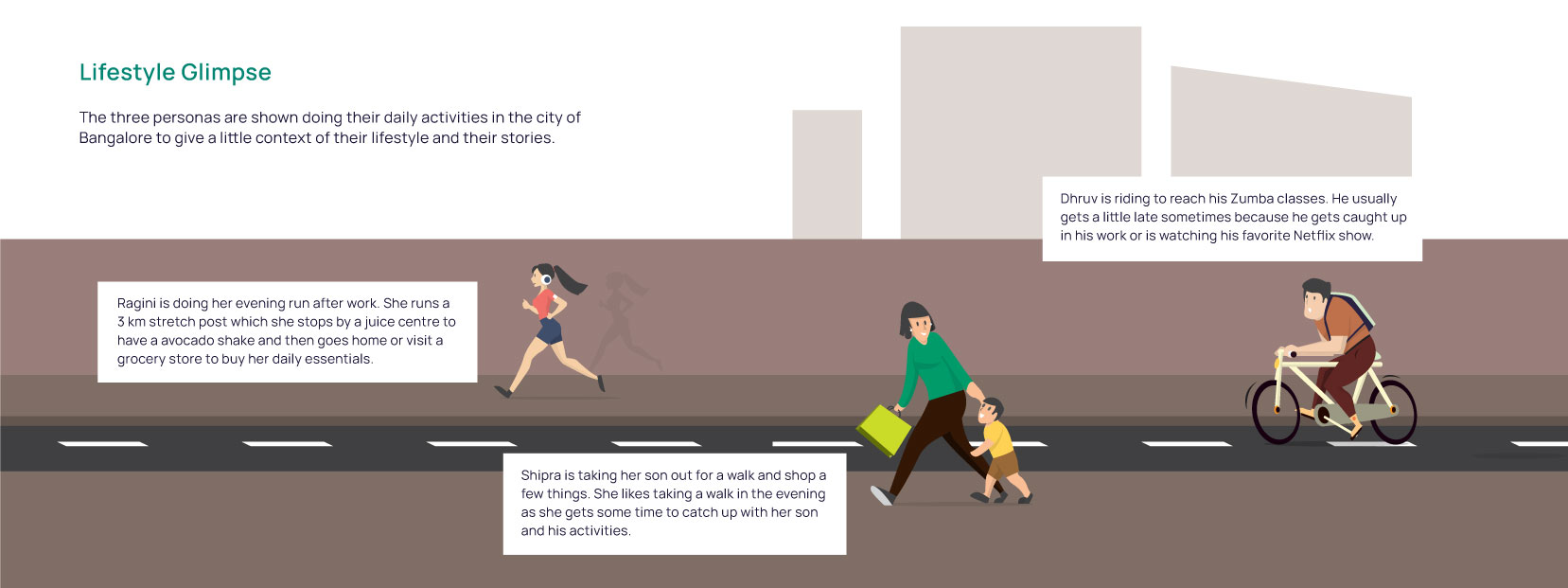

Brainstorming
The brainstorming was done in relation to the How might we's. The exercise was done across 3 days with around 1.5 hours each day. The exercise was participated by 3 participants including me.

We then did affinity mapping of the ideas. The generated ideas categorised under meaningful overheads and further mapped to the larger food procurement & consumption journey
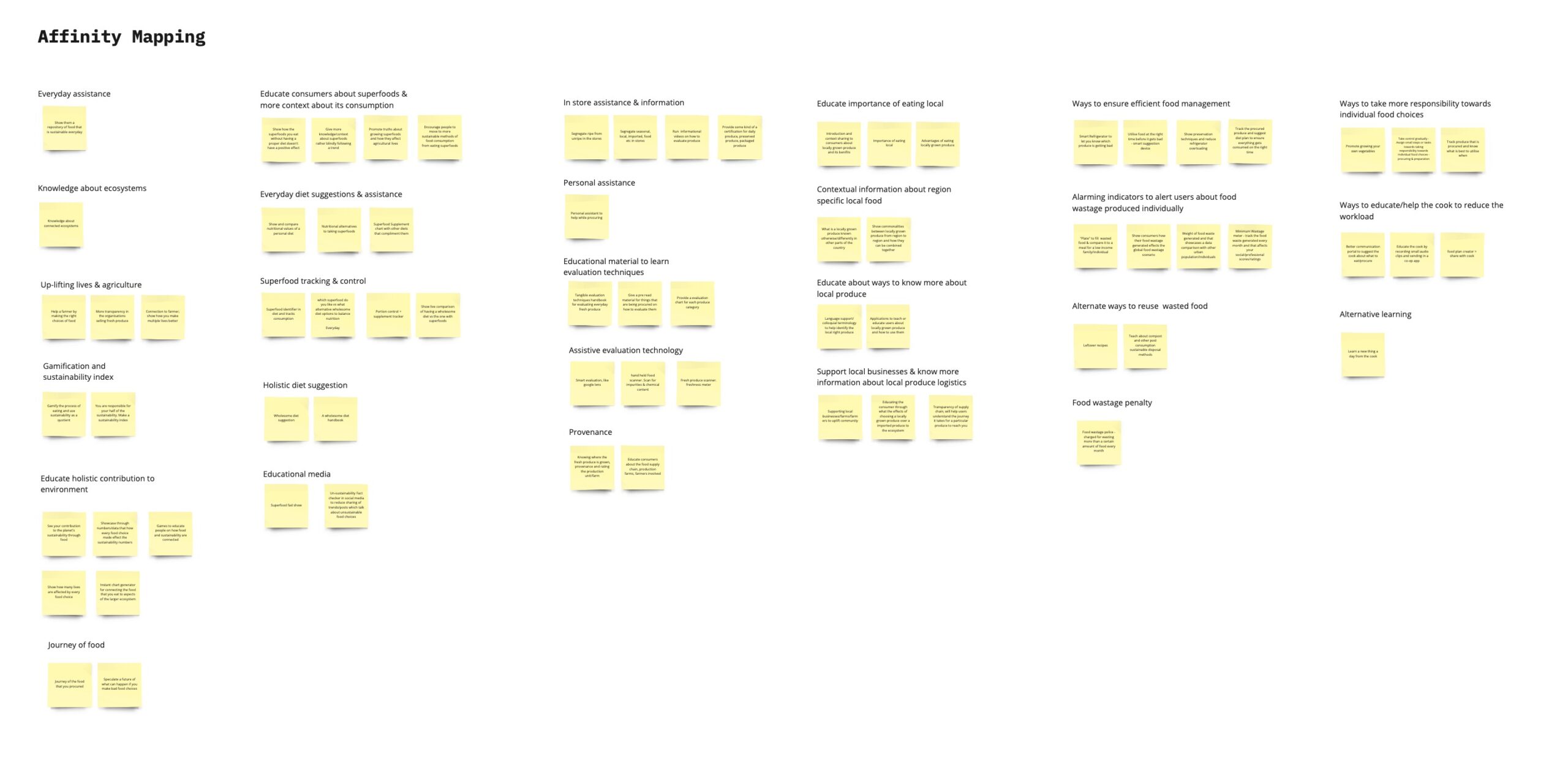
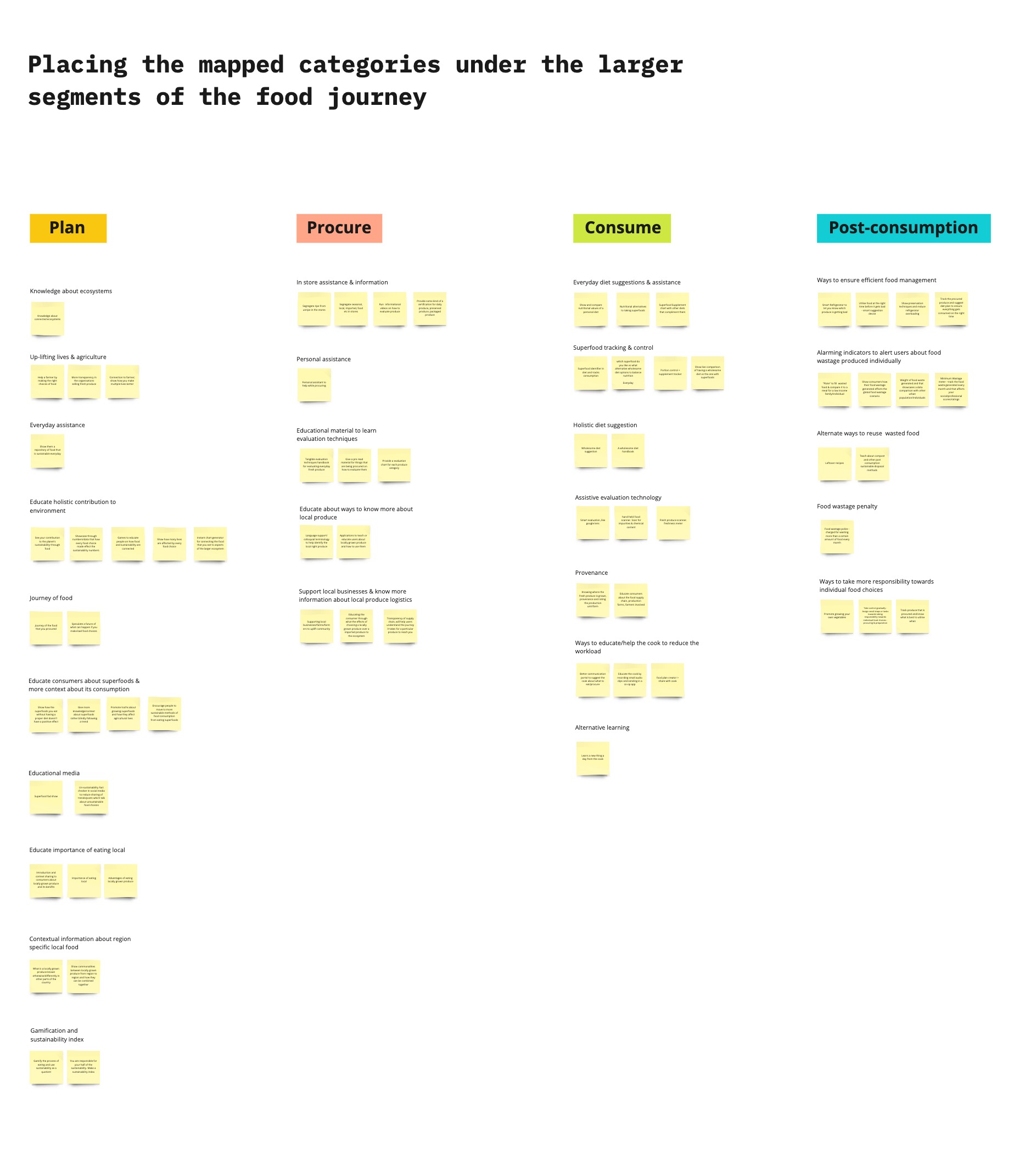
The how might we's and the the ideas were then mapped to the cognitive journey of an user which was created in the earlier stages. This mapping helped us look at the journey as a whole and how these scenarios interacted with each other. This overview also helped us relate the how might we's to the personas.

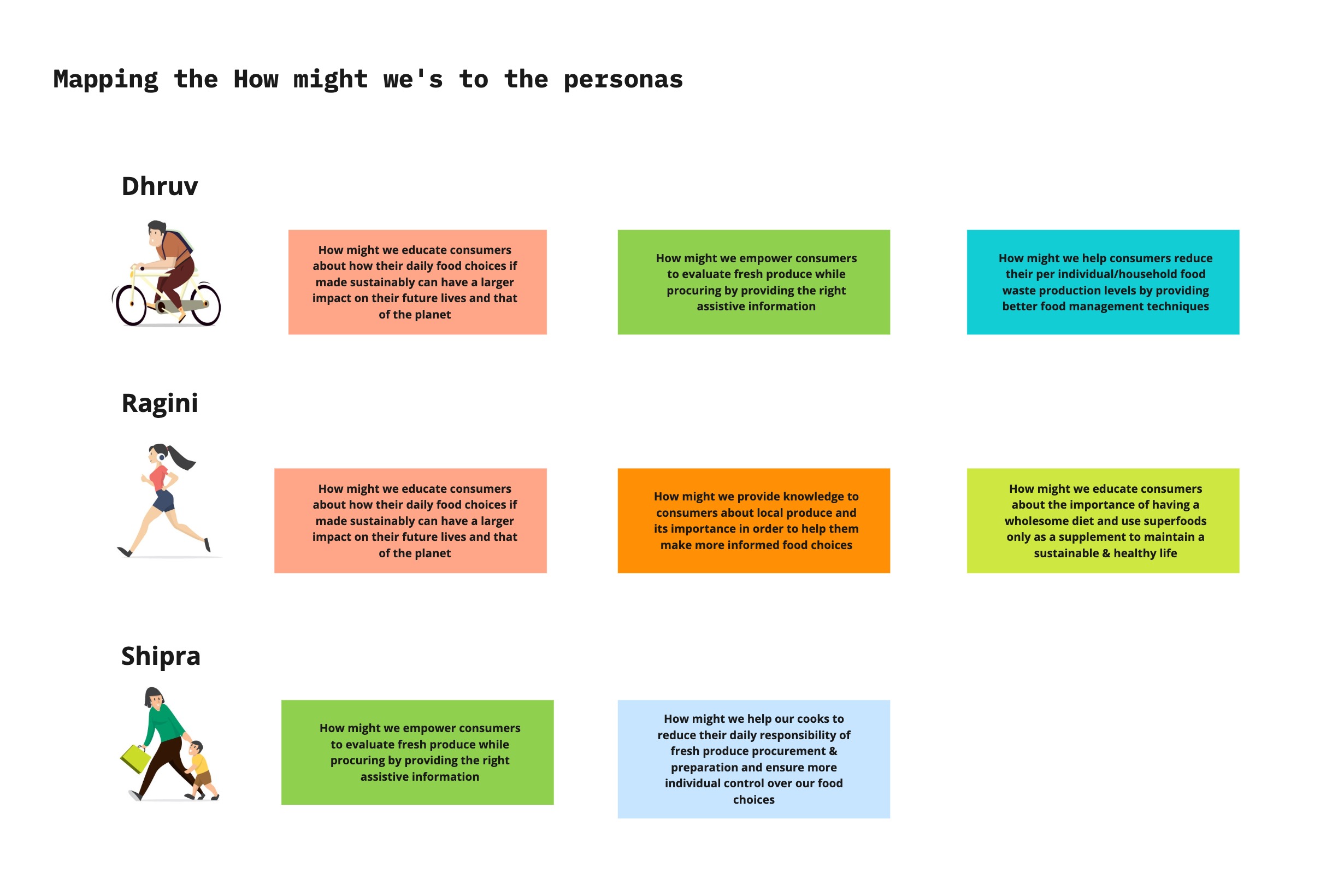

Concepts generation
The ideas and the how might we's were mapped to the personas and that were used to create larger concepts. The concepts created are larger idea chunks combining a few smaller ideas to solve a pain point holistically.
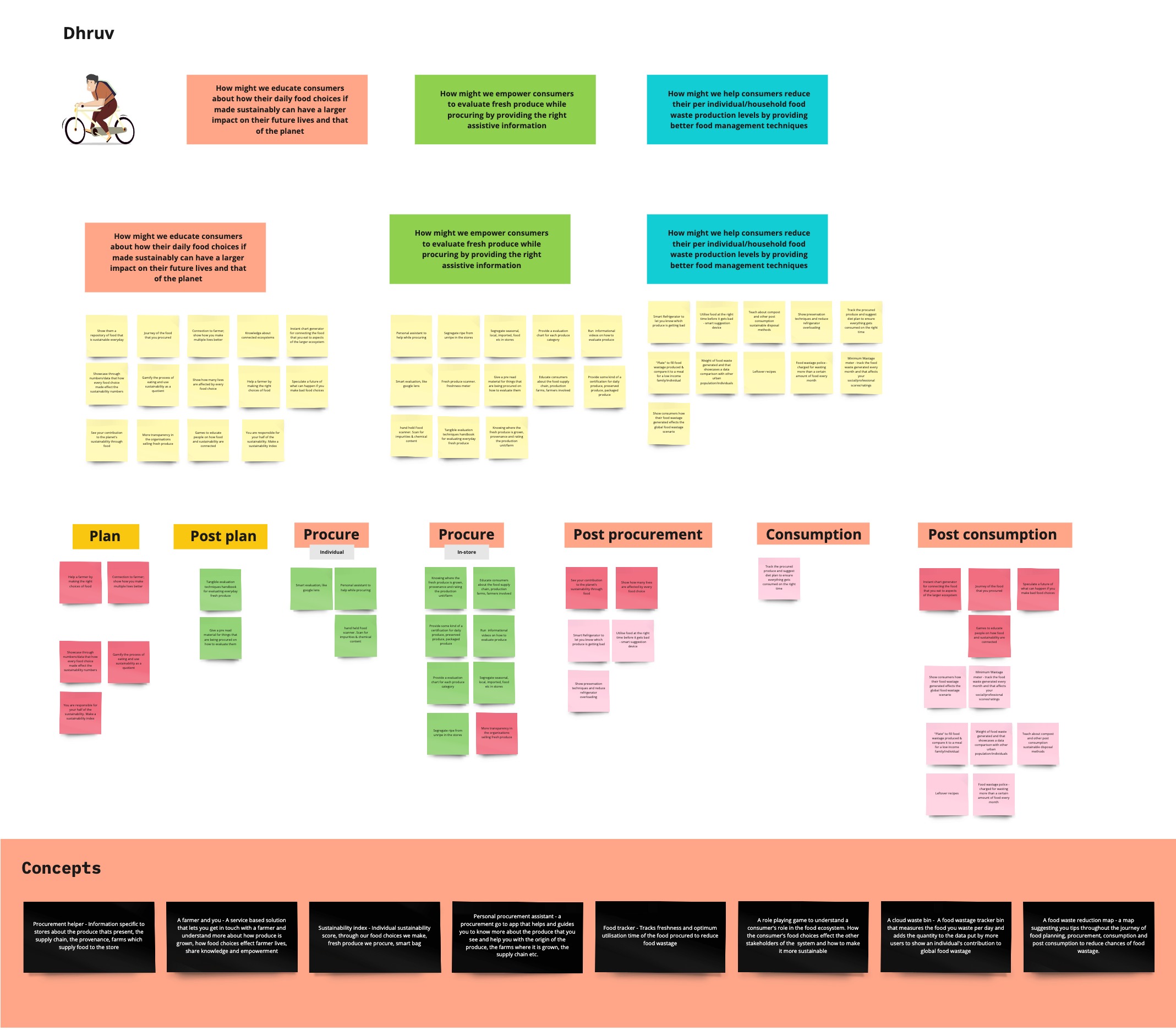


Final Concepts


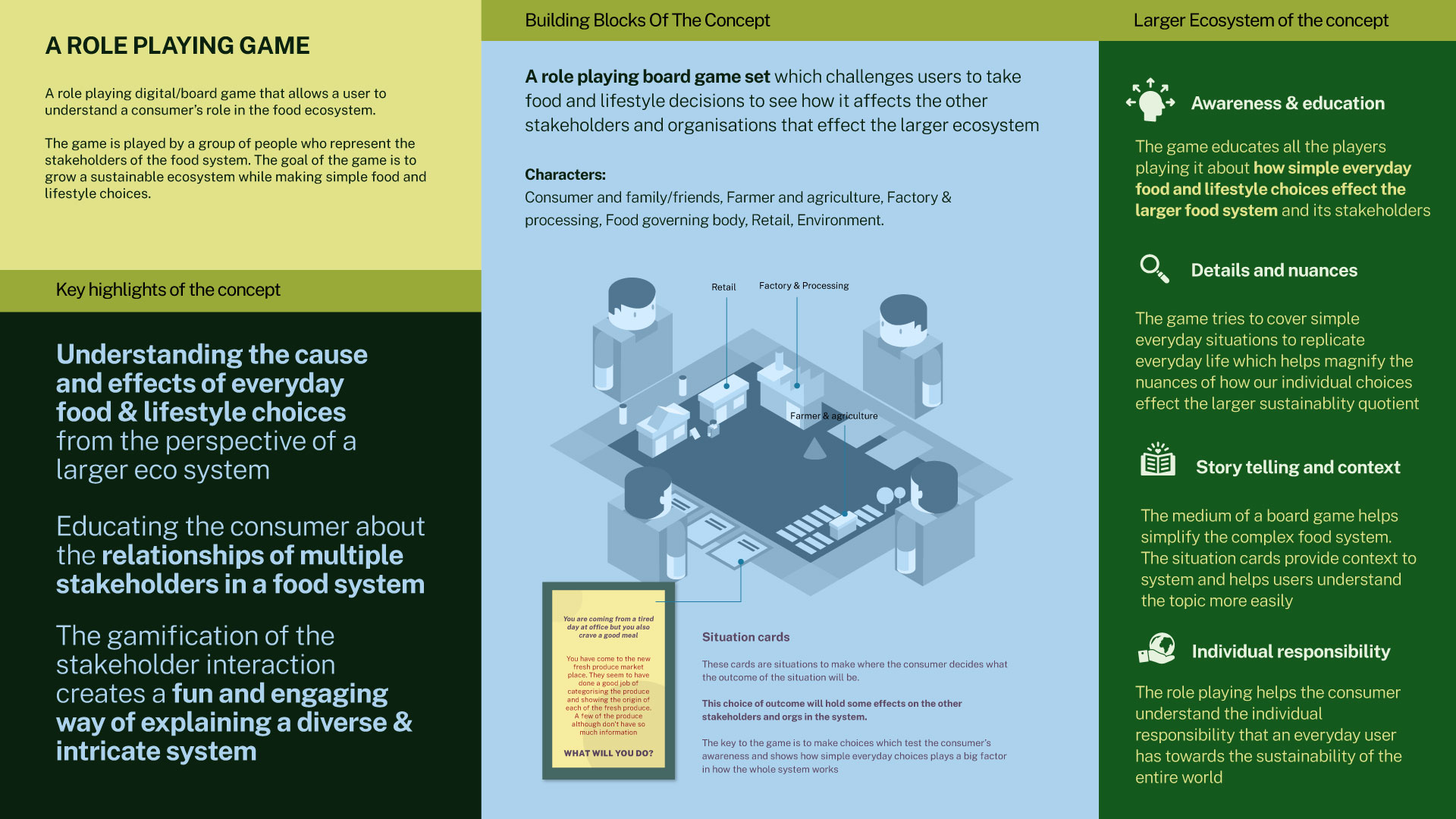
Learnings & Next steps
More than a project this was a journey that gave me a rich and insightful perspective to a very mundane day to day activity of food procurement and consumption. The research phases helped me get first hand perspectives of how individual choices contribute to a larger scenario and how knowledge and awareness are key driving factors to making informed choices. Throughout the project I also realised how tough it is to make a sustainable choice in everyday living and the gap between talking about something and actually doing it. The learnings from this project don't end but evolve as I try to practice the them myself and push to change into a more sustainable human being.
The next steps for the project was to prioritize a concept and prototype it. The prototype and the design features is yet to be updated in the website.
Hey there, this is the default text for a new paragraph. Feel free to edit this paragraph by clicking on the yellow edit icon. After you are done just click on the yellow checkmark button on the top right. Have Fun!
More

Designing a Conversational user experienceConversational UX
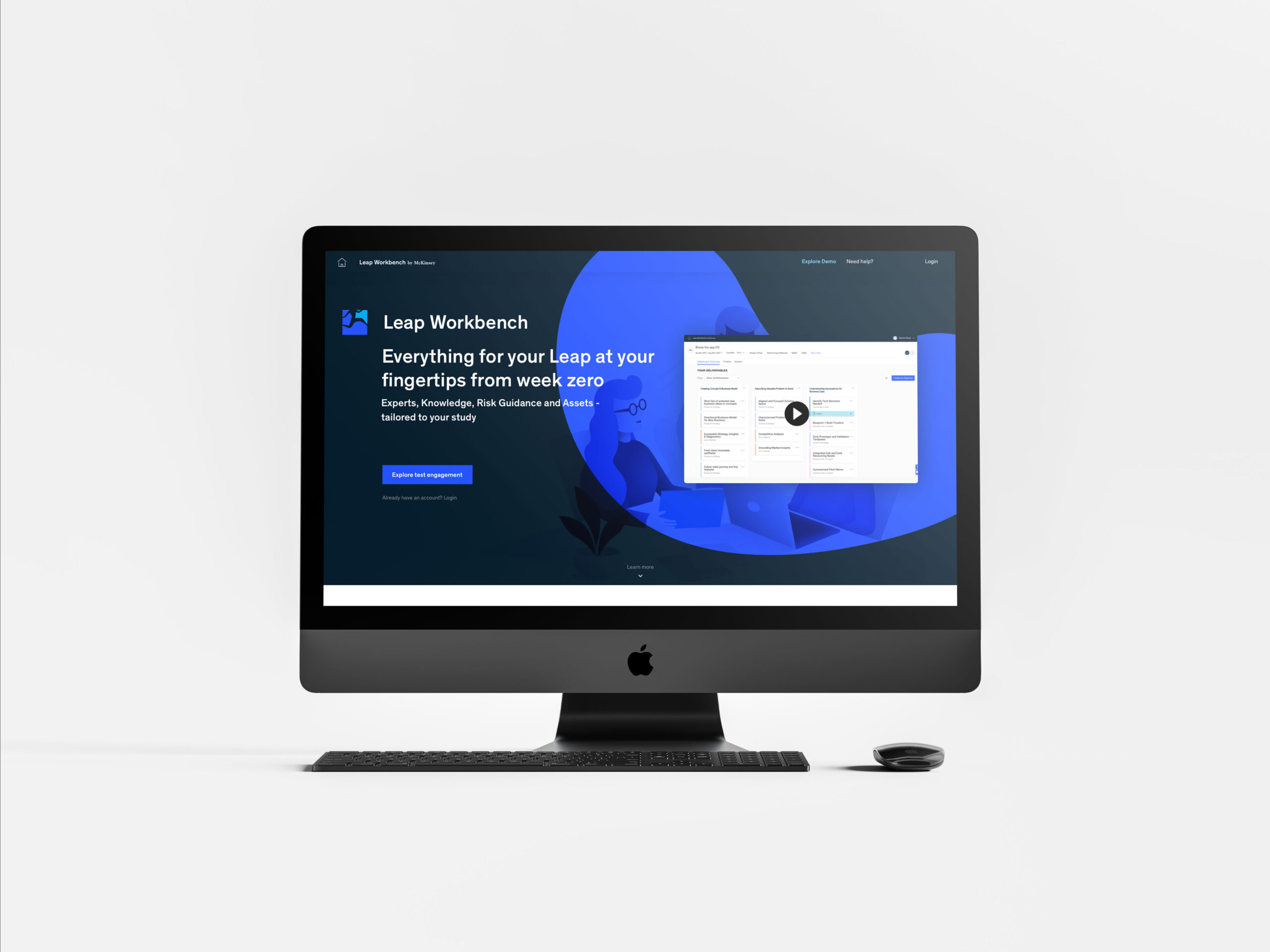
A Knowledge Library & Work management tool: Leap WorkbenchProduct & Experience Design